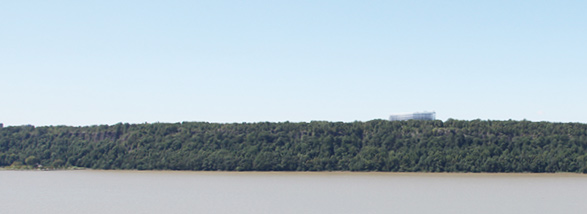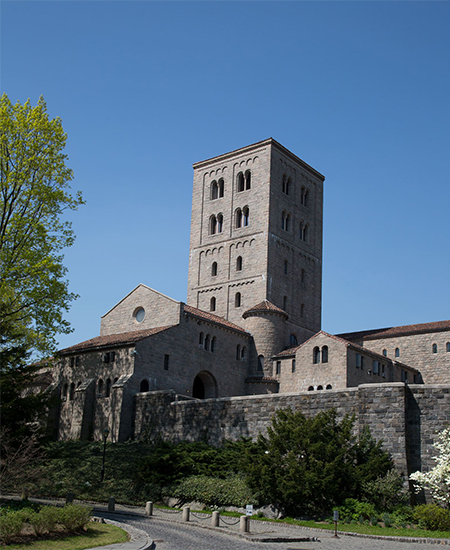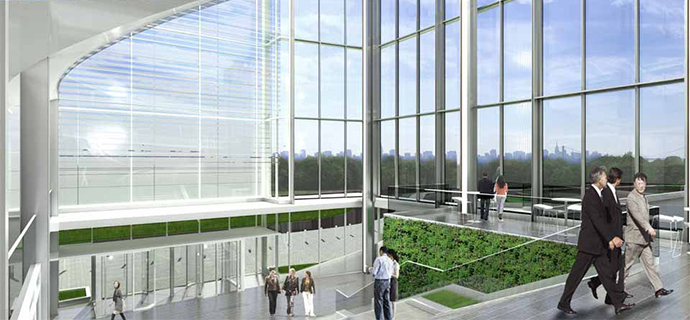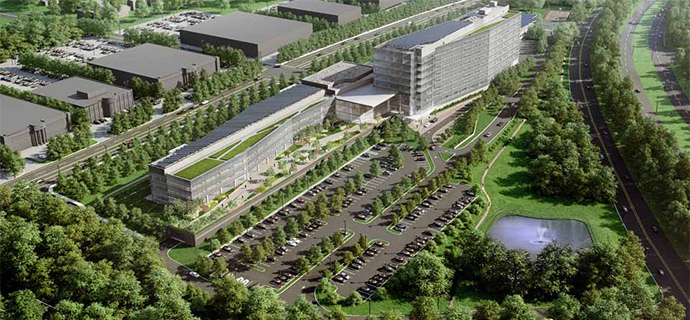Hike the trails along New Jersey’s 20-plus miles of Palisades on an early summer morning, a breeze freshening your gait as you gaze through the forest or at the Hudson River, and you might be tempted to utter, “Life’s good.”
Be careful: Those are fightin’ words.
Why? Those words are the slogan of LG Electronics, the Korean giant that’s based its US operations in Bergen County’s Englewood Cliffs for a quarter century. The company is pursuing a new $300-million, 490,000-sq.-ft. (45,521-sq.-m.), LEED-Platinum North American headquarters that would allow for the creation of 500 new jobs, bringing total occupancy near 1,600.
In June 5 testimony before the New Jersey legislature, John Taylor, vice president of public affairs for LG Electronics USA, summed up the site search:
“Because we have outgrown our current location, six years ago, we embarked on a search for a location to build our new headquarters. We were delighted, after evaluating 200 sites around the country, to find a prime location in Englewood Cliffs — a 27-acre site close to where we currently are located — that meets our corporate requirements. Many of you will know the site at 111 Sylvan Avenue; it was an eyesore, formerly the operations center of a bank and an ugly layout dominated by asphalt parking lots.”
LG chose its New Jersey backyard for the project in 2009, and purchased the parcel in Englewood Cliffs in December 2010. The project has won a number of awards already for its design, its planning and its economic heft. But protests have been loud and long, as opponents of the project argue the new headquarters will violate decades-old building height restrictions and mar an otherwise sylvan view.

Englewood Cliffs’ historic height regulation has been 35 ft., or approximately three stories. The borough’s zoning board in 2012 granted variances to LG for its planned 143-ft. building. After ensuing lawsuits, the changes were modified to allow buildings up to 90 ft. high for parcels between five and 25 acres, and up to 150 ft. high for parcels larger than 25 acres.
As reported in the Bergen Record this month, “In response to subsequent litigation that claimed the rezoning was inconsistent with the borough’s master plan, the town’s Planning Board is now considering a master plan amendment that would support the zoning changes.” However, a new ordinance introduced July 9 (which would not affect LG’s variances) would repeal the zoning changes. The Borough Council also voted to place a referendum on the November ballot concerning building height restrictions.
James F. Hall is executive director of the Palisades Interstate Park Commission, which manages more than 100,000 acres (40,470 hectares) of parklands and historic sites in New York and New Jersey. He says the Commission has “never approved or endorsed the plans,” but had expressed early on a willingness to work with the company on mitigation and screening measures, because of concerns over building height and visual impact from Palisades Parkway and from one of the long hiking trails alongside the Parkway, a national scenic byway.
“Our early technical comments had to do with the ability to screen from those locations,” he says. As for the perspective from the other side of the Hudson, he says the structure would be “clearly visible from across the river in New York, with regards to the view shed of the Palisades themselves.”
Horizon With a History
LG and about 300 supporters broke ground on preliminary construction in November 2013. But as Hall suggests, the protests are more about a broken sky.
At issue are questions that are as much about philosophy and aesthetics as they are about permitting, conservation or corporate responsibility:
- How many jobs must you stack on a clifftop to make people forgive a spoiled view?
- To what degree are people entitled to an unbroken horizon?
- While all scenic vistas may theoretically be created equal, are some people’s views (evoking Orwell) “more equal” than others? (See “Cape Wind, Kennedy.”)

If you suspect there’s some history here, you’re right.
One of the allegedly spoiled views would be from the vantage point of The Cloisters, the Metropolitan Museum of Art’s special museum, established in 1938, known for its medieval art and architecture collection, its setting in Fort Tryon Park and its unsurpassed views of the Hudson and the Palisades. As the Met’s history page reminds us, “In 1917, John D. Rockefeller, Jr. (1874-1960) bought the Billings mansion and began developing the property as a park which he ultimately presented to the City of New York, employing the Olmsted Brothers architectural firm to help him realize his vision for the site. Rockefeller even purchased land on the New Jersey side of the Hudson – now known as the Palisades State Park- to preserve Fort Tryon’s stunning views of the palisades.”
The Park Commission’s own history picks up where that leaves off, describing how mansions such as the Zabriskie estate, built by flour magnate George Albert Zabriskie, were being demolished as late as 1939: “This is one of the buildings visible from the river that has had to be demolished in compliance with the terms of the gift, with a view to the preservation of the skyline of the Palisades,” says the Commission’s history. “Rockefeller had purchased this particular piece of property in 1930. In 1933 he donated it, along with many similar properties he’d acquired around the same time, to the Park Commission, with the request that the Palisades skyline be returned to its natural appearance. This was in response to fears that the construction of the George Washington Bridge, which opened in 1931, would lead to a spate of over-development on the cliff top, marring the Park Commission’s thus-far successful efforts to preserve the Palisades scenery.”
Rockefeller’s predilection for landscapes was not restricted to New York. He, again with Olmsted’s assistance, was a prime mover in the establishment of Acadia National Park along the coast of Maine, among other projects.
View preservation along the Hudson has been an ongoing theme through the decades. After much of Fort Tryon Park was overgrown, a three-year restoration of the garden and reopening of long-lost views of the Hudson and the Palisades was completed in 1988.
Today, Rockefeller’s grandson Larry is among those who have been trying to convince LG to redesign its campus for the landscape’s sake.
Transparent to a Fault
For its part, LG has tried to be as clear as its proposed glass-enclosed building. Its project is becoming a test case in corporate sustainability, responsibility and transparency – and whether a community can bring itself to believe that such corporate missions are real and viable, not just PR ploys.
Company officials have patiently listened and modified their “view of the view” over the nearly five years since they purchased the parcel, adjusting parapet heights, increasing landscape buffers and raising tree heights along the way, as the company aims to complete the project in 2017.
In its presentation of “facts vs. fiction” on the project’s website (to refute published editorials, artist’s renderings and statements about its “tower”), the company states that the new US headquarters will be:
- “A sleek, state-of-the-art glass building which is significantly wider than it is tall. (By definition, a tower is a building or structure higher than it is wide.)”
- “Built on private land a quarter mile back from the Palisades Cliff, not on park property, and not in the middle of the Palisades Interstate Park.”
- “Barely visible above the tree-line from the Cloisters, unlike many taller existing structures already on the New Jersey side of the river. Below is an ACCURATE and honest portrayal of LG’s new HQ, as seen by the naked eye, from the The Cloisters museum on the New York side of the Hudson River. The actual building height in this rendering was verified by independent experts, Neoscape, which floated balloons to the exact height of the building, where it will be constructed — a quarter mile back from the Palisades…”

Responding to protest statements from the Borough of Manhattan and the Met itself about pristine views about to be ruined forever, LG states, “Currently, when standing on the New York side of the Hudson, you can clearly observe several existing structures. These include two 47-story towers under construction and apartment buildings approximately half a mile south of the LG property, as well as Saint Peter’s University to the north.”
As for following the June advice of editorialists from The New York Times and simply redesigning for a low-rise complex, LG says, “A redesign of the building will severely delay the economic and community benefits that the new building will bring to the region. New Jersey needs jobs now! The current design received all necessary approvals from the State of New Jersey, Bergen County and the Borough of Englewood Cliffs. A redesign will mean a new round of approvals, additional architectural and site-planning work, as well as opening the doors to further legal challenges and related financial costs.”
In other words, back to the drawing board … and perhaps to reconsideration of some of those original 200 locations.
Decision Time
The view of some of the projected economic statistics from the project looks to economic developers like a beautiful sunrise.
According to an economic impact study developed by Biggins Lacy Shapiro in September, the project is expected to bring more than $500 million to the State of New Jersey over a 20-year period. LG’s new headquarters will bring a total of $2.5 million in annual tax revenue to Englewood Cliffs, where the municipal budget is about $13.5 million. Among the study’s other conclusions:
- The cumulative benefit of ongoing revenues to New Jersey over 20 years, assuming 3-percent annual inflation, will be $538 million, which equates to a present day value of more than $287 million.
- Once fully phased-in by 2020, the LG project will generate an annual benefit of approximately $26 million in direct, indirect and induced recurring revenues.
- The construction of LG’s new headquarters will also generate an estimated $25 million in one-time direct, indirect and induced revenues.
A bill prohibiting development over 35 ft. from within 2,000 ft. of the Palisades went to the full New Jersey State Senate in June, as an identical bill awaiting hearing in the Assembly. As reported in the Bergen Record, the bill would apply retroactively “to any development that did not have a completed foundation as of May 1. That includes the 143-foot office building LG Electronics plans to build in Englewood Cliffs.”
In his June testimony, LG’s John Taylor noted the many levels of local government support, and the company’s $2-million investment in an “LG Science & Environmental learning Center as a centerpiece of the new corporate campus, an interactive center where New Jersey school children will be able to learn about technology and sustainable living.” He also noted the environmental attributes of the campus:
“As part of our design and landscaping efforts, LG will transform the current sea of asphalt by increasing the percentage of green space by more than 50 percent, and by planting more than 700 new trees. Because we are interested in the area’s geology and wetlands, we are creating a buffer of 120 feet. And, the new site design will reduce potentially harmful rainwater runoff which is currently eroding the Palisades, not to mention helping to eliminate flooding issues for LG’s neighbors in the area. We have been sensitive to the environmental concerns from day one of this project.”
The company went through six public meetings in 2011 alone. Moreover, said Taylor, “to address some of these issues, LG participated in five court-supervised mediation sessions in May and June 2013 with the plaintiffs challenging the project’s approval. However, because the other side was unwilling to compromise, the mediator decided to end negotiations. Then, last summer, the New Jersey Superior Court reaffirmed the decision of the local municipality to approve the project. LG has begun to clear the site and construction planning is well under way.
“For this landmark million project, it is important to note that LG is not receiving any government incentives,” Taylor concluded. “We are investing $300 million to create a world-class green office campus. Our lasting legacy will be a greener corporate campus that is a driver of economic growth. We are very proud of this project. We would like to stay in New Jersey. So we ask that you resist imposing any limits on a project that has secured all needed approvals, will be incredibly beneficial for the economy and educational opportunities in Englewood Cliffs, Bergen County, and the State.”

